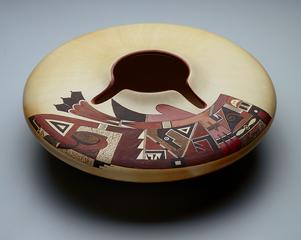
| The creamy color of the seed jar is typical of Hopi clay, which is gray before firing but turns shades from cream or yellow to apricot or light red after firing. The jar has a minimal amount of painted design. Quotskuyva says that sometimes "that is all the pot wants, and you have to let it go." Ancient designs inspired the ABSTRACT and GEOMETRIC SHAPE forms of the jar; its triangles, rectangles, parallel lines, and spirals traditionally represent rain, lightening, and wind. |  |
 |
The seed jar also contains distinguishing Nampeyo family designs. Three triangle-tipped feathers sweep across the top of the jar and fan out to the left side of the design as if blown by the wind. |
 |
Farther to the right, in contrast, an angular wing of split feathers looks almost solid and geometric. Birds, especially eagles, play an important ceremonial role in the life of the Hopi people. The dry land of the mesas requires plenty of rain to produce the crops of corn, melons, peaches, gourds, squash, and beans that the Hopi rely upon. They believe the spirit of the eagle carries a prayer for rain to the gods on behalf of the people. |

Key ideas.
Where does it come from?
What does it look like?
How was it used?
How was it made?
How big is it?
Who Knows?
Additional resources.
